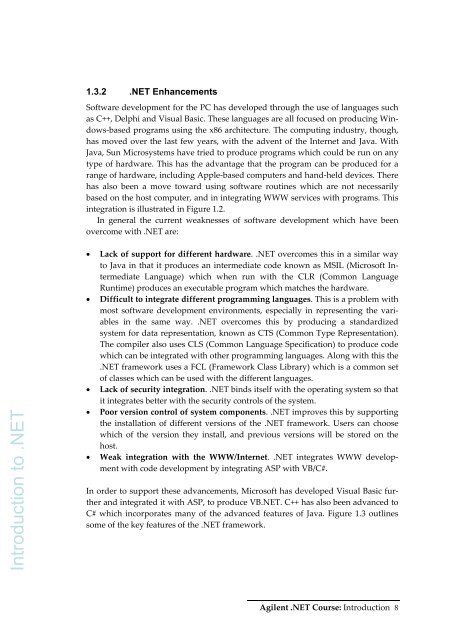Complete set: Intro to C - Bill Buchanan
Complete set: Intro to C - Bill Buchanan
Complete set: Intro to C - Bill Buchanan
Create successful ePaper yourself
Turn your PDF publications into a flip-book with our unique Google optimized e-Paper software.
1.3.2 .NET Enhancements<br />
Software development for the PC has developed through the use of languages such<br />
as C++, Delphi and Visual Basic. These languages are all focused on producing Windows‐based<br />
programs using the x86 architecture. The computing industry, though,<br />
has moved over the last few years, with the advent of the Internet and Java. With<br />
Java, Sun Microsystems have tried <strong>to</strong> produce programs which could be run on any<br />
type of hardware. This has the advantage that the program can be produced for a<br />
range of hardware, including Apple‐based computers and hand‐held devices. There<br />
has also been a move <strong>to</strong>ward using software routines which are not necessarily<br />
based on the host computer, and in integrating WWW services with programs. This<br />
integration is illustrated in Figure 1.2.<br />
In general the current weaknesses of software development which have been<br />
overcome with .NET are:<br />
duction <strong>to</strong> .NET<br />
<strong>Intro</strong><br />
• Lack of support for different hardware. .NET overcomes this in a similar way<br />
<strong>to</strong> Java in that it produces an intermediate code known as MSIL (Microsoft Intermediate<br />
Language) which when run with the CLR (Common Language<br />
Runtime) produces an executable program which matches the hardware.<br />
• Difficult <strong>to</strong> integrate different programming languages. This is a problem with<br />
most software development environments, especially in representing the variables<br />
in the same way. .NET overcomes this by producing a standardized<br />
system for data representation, known as CTS (Common Type Representation).<br />
The compiler also uses CLS (Common Language Specification) <strong>to</strong> produce code<br />
which can be integrated with other programming languages. Along with this the<br />
.NET framework uses a FCL (Framework Class Library) which is a common <strong>set</strong><br />
of classes which can be used with the different languages.<br />
• Lack of security integration. .NET binds itself with the operating system so that<br />
it integrates better with the security controls of the system.<br />
• Poor version control of system components. .NET improves this by supporting<br />
the installation of different versions of the .NET framework. Users can choose<br />
which of the version they install, and previous versions will be s<strong>to</strong>red on the<br />
host.<br />
• Weak integration with the WWW/Internet. .NET integrates WWW development<br />
with code development by integrating ASP with VB/C#.<br />
In order <strong>to</strong> support these advancements, Microsoft has developed Visual Basic further<br />
and integrated it with ASP, <strong>to</strong> produce VB.NET. C++ has also been advanced <strong>to</strong><br />
C# which incorporates many of the advanced features of Java. Figure 1.3 outlines<br />
some of the key features of the .NET framework.<br />
Agilent .NET Course: <strong>Intro</strong>duction 8










![Unit 5. Switches and VLANs [PDF]](https://img.yumpu.com/34422504/1/184x260/unit-5-switches-and-vlans-pdf.jpg?quality=85)





